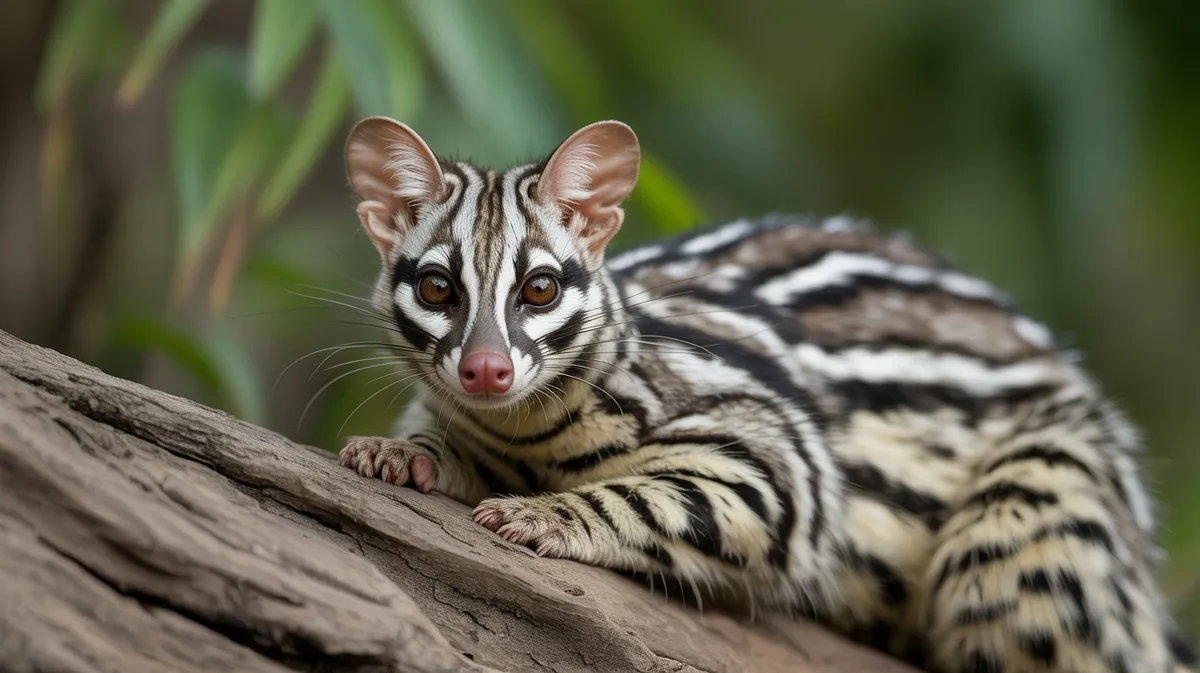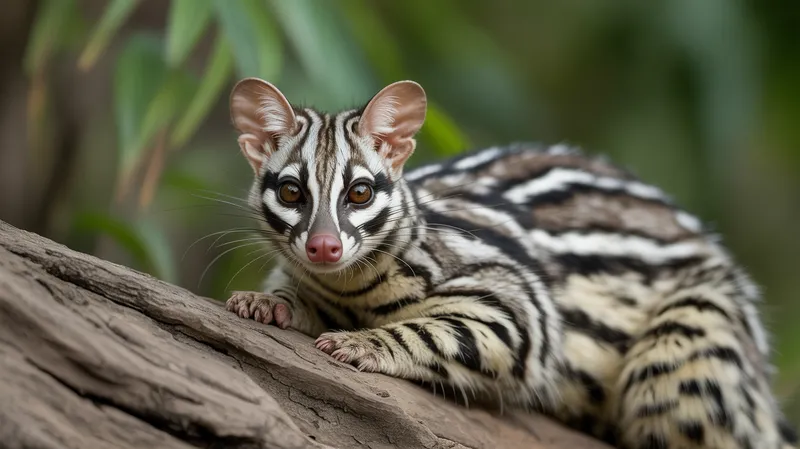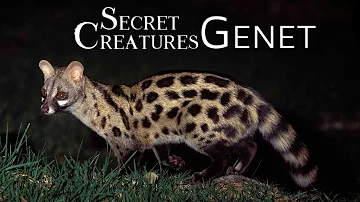
Common Genet
Genetta genetta

Meet the Common Genet
The common genet is a slender, cat-like carnivore known for its elongated body, spotted coat, and long, banded tail. Native to Africa but also widespread in parts of Europe, particularly the Iberian Peninsula and France, this nocturnal animal is an agile climber and skilled hunter. Genets are solitary and secretive, preferring to avoid human presence and spending much of their time in dense vegetation or trees. Despite their resemblance to cats, genets are more closely related to mongooses and civets.
Classification
Mammal
Habitat
Woodlands, forests, savannas, and scrublands
Diet
Carnivore
Lifespan
8-13 years
Conservation
Least Concern
Weight
1.2-2.5 kg
📖Fascinating Facts
Nocturnal Hunter
Genets are primarily active at night, using their keen senses to hunt small mammals, birds, reptiles, and insects.
Expert Climber
They have remarkable agility in trees, often leaping between branches and descending tree trunks headfirst.
Unique Scent Glands
Like other members of the Viverridae family, genets possess scent glands near the base of their tails, which they use for marking territory.
📋Detailed Description
The common genet (Genetta genetta) is a slender, medium-sized carnivoran, typically measuring 40–60 cm in body length, with a tail nearly as long as its body (40–55 cm), and weighing between 1.2 and 3.2 kg. Its fur is soft and dense, pale grey to yellowish with distinct black spots arranged in longitudinal rows, and a strikingly banded tail with 8–13 black rings ending in a black tip. The head is small and pointed, with large, rounded ears and prominent, forward-facing eyes adapted for nocturnal vision. The legs are relatively short, and the feet are semi-digitigrade with partially retractile claws, aiding in climbing and prey capture. Genets possess well-developed anal glands that secrete a musky substance used in territorial marking. Highly agile and flexible, they are adept climbers and can leap several meters between branches. Their elongated, lithe bodies enable them to navigate dense undergrowth and tree canopies with ease. The common genet is primarily nocturnal and solitary, spending daylight hours resting in tree hollows, dense vegetation, or rock crevices. Its vocalizations include growls, hisses, and a characteristic 'clicking' sound, used in communication and during mating.
💡 Did you know?
Although genets look like felines, they are actually members of the family Viverridae and are not true cats.
🔬Research & Sources
Wikipedia Summary
The common genet is a small viverrid indigenous to Africa that was introduced to southwestern Europe. It is widely distributed north of the Sahara, in savanna zones south of the Sahara to southern Africa and along the coast of Arabia, Yemen and Oman. It is listed as Least Concern on the IUCN Red List.
Last Modified: 5/26/2025
🎭Behavior & Social Structure
Common genets are predominantly solitary and territorial, with individuals maintaining overlapping home ranges that are marked using scent glands and urine. They are crepuscular and nocturnal, emerging at dusk to hunt and forage. Their diet is highly opportunistic and omnivorous, though primarily carnivorous, consisting of small mammals (especially rodents), birds, reptiles, amphibians, insects, and occasionally fruits and berries. Genets are skilled hunters, employing stealth and agility to stalk and pounce on prey, often using their keen sense of smell and acute hearing. They are also known to scavenge and may exploit human-altered environments for food. Social interactions are limited outside the breeding season, though some overlap of home ranges occurs, particularly between males and females. Communication is primarily through scent marking, but also involves vocalizations and body postures during encounters.
👶Reproduction & Life Cycle
The reproductive cycle of the common genet is flexible, with breeding occurring year-round in some regions, though peaks are often observed in spring and late summer. Females exhibit induced ovulation and may have one or two litters per year. After a gestation period of approximately 70–77 days, the female gives birth to 1–4 altricial young, which are born blind and helpless in a secluded den. The mother provides sole parental care, nursing the young for 4–8 weeks. Eyes open at around 10 days, and the young begin to explore outside the den at 4–5 weeks. Weaning occurs at 6–8 weeks, but juveniles may remain with the mother for several more weeks before dispersing to establish their own territories. Sexual maturity is reached at about 1–2 years of age.
🛡️Adaptations & Survival
The common genet exhibits a range of adaptations for arboreal and nocturnal life. Its flexible spine and elongated body facilitate agile movement through dense vegetation and trees. Partially retractile claws and padded feet provide excellent grip on branches and rocky surfaces. Large eyes with vertical pupils enhance night vision, while sensitive vibrissae (whiskers) aid in navigating dark environments. The spotted and banded pelage provides camouflage among dappled light and shadows. Acute senses of smell and hearing are crucial for detecting prey and avoiding predators. Anal scent glands are used for territory marking and communication. Genets are also capable swimmers and can escape predators by taking to water if necessary.
🎨Cultural Significance
The common genet has a notable history in human culture, particularly in the Mediterranean and North Africa. It is believed that genets were introduced to southwestern Europe by humans, possibly during the Moorish occupation, for pest control or as exotic pets. In some African and Iberian folklore, genets are associated with cunning and agility. Their pelts have been used in traditional garments, and in some regions, they were kept in homes to control rodent populations, much like domestic cats. In ancient Egypt, genets were occasionally depicted in art and may have been semi-domesticated. Today, they are sometimes kept as exotic pets, though this practice is discouraged due to their wild nature.
🔬Recent Research & Discoveries
Recent genetic studies have clarified the phylogenetic relationships within the genus Genetta, confirming the common genet's African origin and subsequent introduction to Europe. Ongoing research focuses on population genetics, ecological adaptability, and the impact of habitat fragmentation on genetic diversity. Camera trap studies have provided insights into their nocturnal activity patterns, home range sizes, and interactions with sympatric carnivores. Stable isotope analysis has been used to assess dietary flexibility across different habitats. There is also interest in the role of genets in controlling rodent populations and their potential as bioindicators of ecosystem health. Conservation genetics is a growing field, particularly in fragmented or isolated populations.
🎥Wildlife Videos

Genet Nature, Documentary 2018 HD.
Genet Nature Documentary 2018 HD. In the forest of Spain resides little creature that originates from the African continent. Genet ...
Roberto Channel

Into the Wild: A Genet's Tale | Free Documentary Nature
Into the Wild: A Genet's Tale | Wildlife Documentary Watch 'Wildlife's Rebirth - A True Natural Treasure' here: ...
Free Documentary - Nature

Secret Creatures: Genet
The Large-Spotted Genet has a shoulder height of 210 mm, but this species is short legged. The elongated body has a length of ...
Lion Mountain TV

A Genet's Tale - Go Wild
In a hidden corner of the Mediterranean forest three young genet cubs begin to discover the world. The little female will change ...
Go Wild

What in the World is a Fishing Genet National Geographic
Rumdul

The Genet : Night Stalker | WILD NATURE
The Genet: Night Stalker | WILD NATURE. The Genet is the Original Night Stalker, and is mainly nocturnal but are often spotted ...
Lion Mountain TV
🌍Habitat Information
The Common Genet typically inhabits Woodlands, forests, savannas, and scrublands environments. Common Genets have adapted to their environments with specialized features and behaviors.
Primary Habitat:
Woodlands, forests, savannas, and scrublands
More detailed habitat information will be available soon.
🛡️Conservation Status
The Common Genet is currently classified as Least Concern. Conservation efforts are crucial for preserving this species for future generations.
Common Threats:
- 🏠Habitat loss and fragmentation
- 🌡️Climate change impacts
- 🎯Hunting and poaching
- 🏭Human-wildlife conflict
⚠️Threats & Conservation Challenges
Currently, the common genet faces few significant threats and is classified as Least Concern by the IUCN, owing to its wide distribution, adaptability, and stable population trends. However, localized threats include habitat loss and fragmentation due to agricultural expansion, urbanization, and deforestation. In some areas, genets are hunted for their pelts or persecuted as poultry predators. Road mortality and accidental trapping are additional risks in human-dominated landscapes. Despite these pressures, the species' ecological flexibility and use of secondary habitats have enabled it to persist in many altered environments. Ongoing monitoring is recommended to detect potential declines, especially in regions where habitat change is rapid.
🔬Scientific Classification
Scientific Name
Genetta genetta
Classification Hierarchy
🔍 About Taxonomic Classification
Taxonomic classification is a hierarchical system used by scientists to classify and organize living organisms based on shared characteristics and evolutionary relationships.
The system moves from broad categories (Kingdom) to increasingly specific ones, with each animal's scientific name typically consisting of its Genus and species.
📝Community Notes
Share your observations and insights about the Common Genet with our community of wildlife enthusiasts.
Join Our Community
Sign in to share your observations and connect with fellow wildlife enthusiasts.
Sign In to ContributeNo community notes yet
Be the first to share your observations about the Common Genet!
Explore Common Genet
Select a tab above to learn more about this amazing animal.
📸Photo Gallery
No photos available for this animal yet.
🌟Discover More Wildlife
Continue your journey of discovery with more fascinating animals from our database
